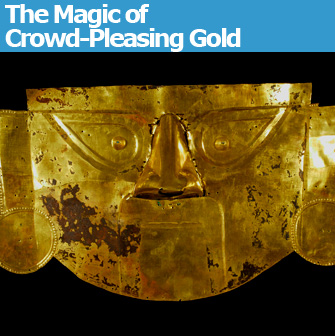|
|
|
Gold mask from the Sicán Culture (800-1350). © Brüning National Archaeological Museum, Lambayeque-Instituto Nacional de Cultura del Perú, Lima. Photo © Joaquín Rubio Roach |
“Gold” is the magical word, guaranteed to pull in the crowds, in the name of the Pinacothèque de Paris’s new exhibition, “Gold of the Incas: Origins and Mysteries,” but some …
 |
| Gold mask from the Sicán Culture (800-1350). © Brüning National Archaeological Museum, Lambayeque-Instituto Nacional de Cultura del Perú, Lima. Photo © Joaquín Rubio Roach |
“Gold” is the magical word, guaranteed to pull in the crowds, in the name of the Pinacothèque de Paris’s new exhibition, “Gold of the Incas: Origins and Mysteries,” but some of the most stunning objects in this show – which is filled with one beautiful piece after another – are not made of gold at all, and most of the objects are not from the Incan period, which lasted only a little over a century, from 1400 to 1533, but from the various cultures that led up to and influenced it.
A starkly simple rounded stone monolith (100 B.C.E.-600 C.E.) from the Recuay Culture, for example, charms with its cartoon-like face and square nose. A vase with equally plain surface and pleasingly rotund shape has only a tiny carved monkey climbing up it for decoration. One ceramic bottle is covered with a marvelous bestiary of animals and birds, while another takes the shape of a fat coiled snake. An anthropomorphic vase looks hauntingly human in spite of the colorful geometric pattern covering its features.
The show starts with a brief overview of the various cultures preceding the Incas, with only a few pieces for most of them, then switches to a thematic approach, with pieces illustrating the amazingly sophisticated metalwork of the various cultures, rituals, civil war and sacrifice, cosmogony and myths, and funeral rites.
The last room, covering Incan funeral rites, is the culmination of the show and fulfills the promise of its title with a spectacular blaze of gold objects. It also features a genuine mummy, in a crouching position, from the Inca-Chincha culture (900-1470).
In the Incan civilization, gold was not used as currency; its only value was as a representation of the brilliance of the sun god, incarnated on earth by the Incan emperor. Sadly, many golden Incan treasures were destroyed by the Spanish conquistadors, who melted them down to fill their own coffers.
As usual, the Pinacothèque provides plenty of lengthy wall texts (in French only), but visitors may still feel lost as the exhibition jumps from culture to culture and theme to theme, especially since the labels for the objects are not always very informative and it is often difficult to figure out which label goes with which object. It may be a good idea in this case to use the audio guide or buy the iPhone app for the show from the Pinacothèque’s Web site. Or do your own research on the Inca civilization, since this tantalizing taste of the Incas and their predecessors will certainly pique your curiosity.
Don’t miss this show, but do try to go at off-hours (if there are any; perhaps around 6pm on Wednesday?) to avoid the inevitable crowds.
Pinacothèque de Paris: 28, place de la Madeleine, 75008 Paris. Métro: Madeleine. Tel.: 01 42 68 02 01. Open daily 10:30 a.m.-6 p.m. (until 9 p.m. on Wednesday; 2 p.m.-6 p.m. on May 1 and July 14). Admission: €10. Through February 6. www.pinacotheque.com
Order books on Incan art from Paris Update’s Amazon store at no extra cost. Click on your preferred Amazon location: U.K., France, U.S.
Support Paris Update by ordering books from Paris Update’s Amazon store at no extra cost. Click on your preferred Amazon location: U.K., France, U.S.
Reader Reaction: Click here to respond to this article (your response may be published on this page and is subject to editing).
More reviews of Paris art shows.
© 2010 Paris Update
Favorite